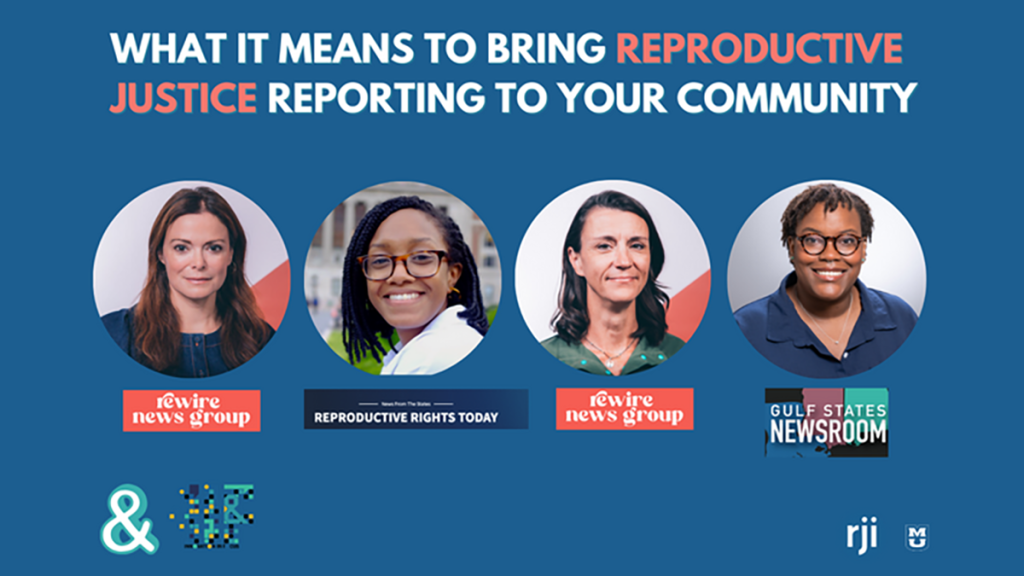
Centering your community in reproductive justice reporting
Sourcing, context and tips for reporting
What do I need to know if I’m covering abortion issues for the first time, or I want to make sure my community is driving and benefiting from that coverage? These were the types of questions we hoped to answer as RJI’s Innovation Team partnered with Rewire News Group for a panel all about practical tips for covering abortion and reproductive health related topics and stories.
Our panelists were Jessica Mason Pieklo, senior vice president and executive editor for Rewire News Group; Elisha Brown, Reproductive Rights Today newsletter author at States Newsroom; and Maya Miller, community engagement reporter for the Gulf States Newsroom. Galina Espinoza, president and editor in chief of Rewire News Group, moderated the discussion.
Here are some of the best practices and advice that were shared during this discussion:
Use precise and accurate language
When reporting on abortion and reproductive health stories, it’s important to use clear, accurate and inclusive language. Rewire News Group provided its own style guide, which helps flag terms introduced by anti-abortion groups, clarifies confusing language, and defines and explains words used in reproductive health care.
Mason Pieklo defined the term “reproductive justice” and explained what it means to include this perspective in your reporting.
Reproductive Justice: A framework introduced in the 1990s by a group of Black women, focused on the core beliefs that include the right to have children, the right to not have children and the right to nurture those children in a safe and healthy environment. — Jessica Mason Pieklo
“It is also a long-term strategy for change,” Mason Pieklo said. “So when we think about reproductive justice in the context of journalism, it is a lens and an understanding that reporting …on the stories is more than just talking about the laws that may be restricting access to abortion or contraception, for example, but really the ways in which all of [us] interact around having families or not having families, and the ways that systematic barriers implicate those.”
Panelists also shared how important it is to include gender-neutral language such as “pregnant people” to reflect how abortion legislation can affect the lives of trans and nonbinary folks. However, as Brown noted, “women” may occasionally be the most accurate term, such as when referring to a federal study that only included cisgender women in the analysis.
The 19th and NPR both have pages on their sites that explain their avoidance of terms like “pro-life” and define terms frequently used in abortion restrictions like “fetal viability” or “medication abortion.”
A bonus tip from Abby Johnston at the 19th: Be specific — If you’re talking about abortion, use the word abortion. Reproductive health care is the term for comprehensive care, but be wary of politicians who use it to mask the impacts of legislation specifically on abortion.
Know the context around medication abortion
Brown said one of the first lessons she learned when covering reproductive rights was debunking the assumption that most abortions require surgery or a procedure. She learned that more than half of all non-hospital abortions are through medication, as the Guttmacher Institute reported in 2022. This context is important to include, she said.
With increasing legislation focused on medication abortion, Brown found it helpful to educate herself about the two different pills — mifepristone and misoprostol — and specifically asked medical professionals about how medication abortion works, how many doses someone would need and more.
More examples of when to contextualize statements, stats
An easy line to add when talking about six-week abortion bans is noting that this is “before most people realize they’re pregnant.” Mason Pieklo said this helps readers understand who is affected by this legislation.
Miller said she’s found it especially important to include context about maternal health access when writing about anti-abortion clinics. She can report what the clinic staff say they offer, while also writing about the nurse and doctor staffing shortages in the area and the number of hospitals that have closed. “Contextualizing has allowed me to present the truth of what is being said,” Miller said.
In a recent newsletter post-elections, Brown followed up a statement from a candidate who lost the state Supreme Court seat in Pennsylvania — that “Democrats had nothing to use against me except for the abortion issue” — with specific numbers about where each candidate received campaign funding.
Communities with active abortion bans
When reporting in states like Louisiana, Mississippi and Alabama where there are total abortion bans, Miller said she goes beyond the breaking news stories by thinking about what people in her community need to know.
If someone in the Rural Delta or on the Gulf Coast is forced to care for a child, how close is the nearest grocery story? Where is the nearest hospital? What resources are available for that hypothetical child?
Reporters can also look for people who are still providing reproductive health care in the area or coordinating rides to states without complete bans.
Always ask the follow-up questions
It’s important to not just ask lawmakers what they hope to do with this new restriction that just passed in your state, Mason Pieklo said, but also ask how they plan to enforce it. Because you can’t ban abortion without enforcing it with law enforcement or some expansion of the state.
“As journalists, we have a responsibility for folks to understand that a ban on your reproductive capacity is an expansion of police power and to explain it to people like that,” Mason Pieklo said.
Or, if a lawmaker tells you that this bill will improve women’s health, follow-up with “how” and look for the data that backs up (or debunks) what their answer is.
Reporting tips: Be sensitive and compassionate
The first step, Miller said, is to meet people where they are, such as not requiring them to come to your unfamiliar newsroom to speak. Then, take the time to talk to the source before interviewing and be transparent about why you’re reporting this story and why sharing their experience is important to you.
“It’s a negotiation: What are you willing to tell? And what safety am I willing to provide in that conversation?” Miller said.
Mason Pieklo added that it’s wise to avoid cold calling providers. Often, these providers are under surveillance or may be receiving threats from protesters, so a call from a reporter listing off questions could be off-putting or damage any potential trust between that provider and that reporter.
Others like freelance journalist Mary Tuma have previously suggested building a rapport with clinic leaders and staff by starting conversations on background or off the record. Another good place to start, she said, is to ask every source: What do you think the local media is not reporting but should be reporting?
Stories that need to be told more often in reproductive health
Brown said she would like to see more reporting about access to postpartum Medicaid for undocumented migrants.
Other panelists said they want to see more reporting on the impact of restrictions on minors, with Mason Pieklo noting that criminalization cases often fall on younger people. They also wanted to see more coverage about impacts on transgender and nonbinary people.
All the panelists talked about the many issues that overlap, connect or may be affected by restrictions on abortion rights, such as gender-affirming care, fertility care, access to affordable health care, hospital closures, immigration statuses, maternal mortality rates, etc.
Diving deeper into these overlapping issues can give reporters more context and knowledge when reporting about reproductive justice.
“There are no ‘culture war’ issues that are not also economic issues,” Mason Pieklo said. “Reproductive rights, health, injustice falls squarely in the center of that.”
If you’re new to reporting on abortion and reproductive justice
Our panelists had advice if you suddenly find yourself reporting about abortion restrictions or reproductive rights for the first time:
- Covering a new bill or law that aims to restrict abortion? Go to the statute and read it directly.
- Always fact check! Especially when including numbers or percentages, you can double check that you have the same stats as other experts on reproductive health.
- If someone else reported the story first, always give credit.
- If you can’t cover a new restriction thoroughly, acknowledge it and tell your readers you’ll be back with a fuller picture of what this law means for the community.

Sign up for the Innovation in Focus Newsletter to get our articles, tips, guides and more in your inbox each month!

Comments